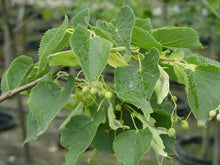Dropmore Linden (Tilia x flavescens 'Dropmore') is a deciduous tree renowned for its elegant form and attractive foliage. It typically develops a pyramidal to oval-shaped crown, with ascending branches that create a symmetrical silhouette. The glossy, dark green leaves are heart-shaped and serrated along the edges, providing a lush appearance during the growing season. In early to mid-summer, the tree produces fragrant, pale yellow flowers in clusters that dangle gracefully from the branches, attracting pollinators like bees and butterflies. These blooms give way to small, round fruits that are inconspicuous but add seasonal interest.
- Size: Dropmore Linden can attain a height of 40 to 60 feet (12 to 18 meters) and a spread of 30 to 40 feet (9 to 12 meters) at maturity.
- Soil: Plant in moist, well-drained soil that is slightly acidic to neutral in pH.
- Sunlight: Prefers full sun to partial shade for optimal growth and flowering.
- Watering: Keep the soil consistently moist, especially during dry periods, but avoid waterlogged conditions.
- Pruning: Minimal pruning is typically required, primarily for shaping and removing dead or damaged branches. Prune in late winter or early spring before new growth emerges.
- Fertilization: Apply a balanced fertilizer in early spring to support healthy growth.
- Mulching: Apply a layer of mulch around the base of the tree to retain soil moisture and suppress weed growth.
- Pests and Diseases: Generally, Dropmore Linden is resistant to most pests and diseases, but occasional issues with aphids or powdery mildew may arise. Monitor the tree regularly and address any problems promptly with appropriate treatments.
- Winter Care: Dropmore Linden is hardy to USDA zones 3 to 8 and typically does not require special winter protection. However, young trees may benefit from wrapping the trunk with burlap to prevent sunscald during harsh winters.




